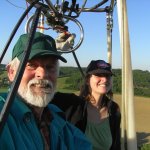 Now not many people know this but the Hot Tom was actually originally designed by David Barker (the former British Balloon & Airship Club’s Chief Technical Officer) back in 1977. In fact it was as a result of making his first burner and the interest taken in it by Dick Wirth of Thunder Balloons that his name was put forward by Dick as a ‘volunteer’ to become the BBAC CTO! He got his first flight and licence back in 1972 and there isn’t much he hasn’t achieved since. A true connoisseur of lightness he has always aimed for the lightest, most practical balloon and reckons that he has pretty much got there with his kit. His prototype was actually finished a year before the Thunder Hot Tom was launched. “I had a better welder than Thunder so mine didn’t leak. After Dick’s death Kenneth Simmonds asked if he could use my welder to make their burners. My welder set up for volume production but finished up only making five before Kenneth sold out to Colt who made their burners in-house.” David explained, “My welder was so upset about the unrecovered money he had spent on tooling he barely ever talked to me again but luckily he had already produced my double.” One of the main differences between the Barker produced burners and the Hot-Tom are the jets, or rather the lack of them. Whereas he used holes in the jet ring Dick Wirth chose to fit jets because he couldn’t be sure his guy could drill straight holes! How good is it? Well, his daughter used one during the course of her training.
Now not many people know this but the Hot Tom was actually originally designed by David Barker (the former British Balloon & Airship Club’s Chief Technical Officer) back in 1977. In fact it was as a result of making his first burner and the interest taken in it by Dick Wirth of Thunder Balloons that his name was put forward by Dick as a ‘volunteer’ to become the BBAC CTO! He got his first flight and licence back in 1972 and there isn’t much he hasn’t achieved since. A true connoisseur of lightness he has always aimed for the lightest, most practical balloon and reckons that he has pretty much got there with his kit. His prototype was actually finished a year before the Thunder Hot Tom was launched. “I had a better welder than Thunder so mine didn’t leak. After Dick’s death Kenneth Simmonds asked if he could use my welder to make their burners. My welder set up for volume production but finished up only making five before Kenneth sold out to Colt who made their burners in-house.” David explained, “My welder was so upset about the unrecovered money he had spent on tooling he barely ever talked to me again but luckily he had already produced my double.” One of the main differences between the Barker produced burners and the Hot-Tom are the jets, or rather the lack of them. Whereas he used holes in the jet ring Dick Wirth chose to fit jets because he couldn’t be sure his guy could drill straight holes! How good is it? Well, his daughter used one during the course of her training.
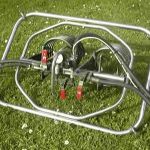 His first burner, made in 1977, was later modified by the addition of an electric valve and third main fuel line (as seen in the photograph) to accommodate an autopilot and was used for all his later Alpine flying. A link valve, probably the first to be used on a double burner, was also fitted. This connects the two coils and allows almost the full power of the both coils to be used from either one of the fuel lines. Almost 50 high Alpine flights using this burner, initially under a Cameron 105 and later a Cameron 120, were made using this burner.
His first burner, made in 1977, was later modified by the addition of an electric valve and third main fuel line (as seen in the photograph) to accommodate an autopilot and was used for all his later Alpine flying. A link valve, probably the first to be used on a double burner, was also fitted. This connects the two coils and allows almost the full power of the both coils to be used from either one of the fuel lines. Almost 50 high Alpine flights using this burner, initially under a Cameron 105 and later a Cameron 120, were made using this burner.
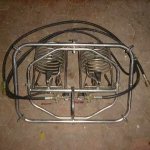 Pictured right is the first out of the original five made to this design. The output from each coil at 80lbs pressure is around 6 million BTU’s. There are 4 jets under each coil each with an adjustable baffle. He explained, “The idea of the baffles is that they stir up the flow of propane from the jets, slowing it down and allowing it to burn lower thus passing more heat on to the coils. If the pressure was high, you could bend them in more, producing more stirring, if the pressure was low you could bend them out.” In practice he found that it was only at great extremes of pressure that it was necessary to adjust the baffles, however, they continued to be used on later designs. A couple of burners like this were sent to Terry Adams in South Africa and one was certainly still in use in 2001 when it was used in the South African Championships.
Pictured right is the first out of the original five made to this design. The output from each coil at 80lbs pressure is around 6 million BTU’s. There are 4 jets under each coil each with an adjustable baffle. He explained, “The idea of the baffles is that they stir up the flow of propane from the jets, slowing it down and allowing it to burn lower thus passing more heat on to the coils. If the pressure was high, you could bend them in more, producing more stirring, if the pressure was low you could bend them out.” In practice he found that it was only at great extremes of pressure that it was necessary to adjust the baffles, however, they continued to be used on later designs. A couple of burners like this were sent to Terry Adams in South Africa and one was certainly still in use in 2001 when it was used in the South African Championships.
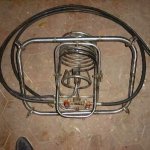 There is always room for improvement and next came the single burner prototype for the Mk 2 double burner and what we would start to recognise as the Hot Tom. David explained that it was originally made as a single as he was having some difficulty visualizing his ideas in 3D. The whole concept revolved around keeping the weight to a minimum. He was fanatical about lightness, “There are no jets, just four holes drilled in the ring that can be seen under the coil. Smith’s valves were used as they were about half the weight of Regos then in common use. The frame was initially made very small, a copy of some Cameron burners of the period, but this quickly proved to be impractical as you found yourself constantly hitting the support poles and wires with your head.” The sections inserted to increase the size can be clearly seen. Output worked out at about 9 million BTU at 80 lbs pressure. Its no coincidence that this burner looks very similar to the Thunder Mk 2, the Hot Tom as Dick Wirth (of Thunder) and David exchanged ideas during its development. Whereas Dick’s ideas were commercial his were private and in the end the build quality of the Thunder version led to leaks in the coils and, as we mentioned earlier, his never did.
There is always room for improvement and next came the single burner prototype for the Mk 2 double burner and what we would start to recognise as the Hot Tom. David explained that it was originally made as a single as he was having some difficulty visualizing his ideas in 3D. The whole concept revolved around keeping the weight to a minimum. He was fanatical about lightness, “There are no jets, just four holes drilled in the ring that can be seen under the coil. Smith’s valves were used as they were about half the weight of Regos then in common use. The frame was initially made very small, a copy of some Cameron burners of the period, but this quickly proved to be impractical as you found yourself constantly hitting the support poles and wires with your head.” The sections inserted to increase the size can be clearly seen. Output worked out at about 9 million BTU at 80 lbs pressure. Its no coincidence that this burner looks very similar to the Thunder Mk 2, the Hot Tom as Dick Wirth (of Thunder) and David exchanged ideas during its development. Whereas Dick’s ideas were commercial his were private and in the end the build quality of the Thunder version led to leaks in the coils and, as we mentioned earlier, his never did.
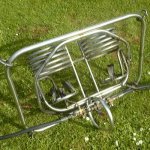 Come 1980 David decided it was time to upgrade and develop his personal Mk 2 double burner that little bit more. The main improvements were the addition of a quiet burner, visible on the left hand coil and incorporating a Cameron screw valve, connected into the system via Thunder hardware. Using the Smiths valve it weighs in at around 11 Kg including fuel lines and produces a total of around 18 million BTU at 80 lbs pressure if you turn both burners on. He freely admits that it doesn’t look as sophisticated as some of the 25kg models that are around but is much easier to carry. Apart from mountain flights it is the burner he has used the most and he has no desire to design a Mk3. David reckons that all in all he was very lucky explaining that, “I made the design, and did a lot of the other stuff, but for the stainless welding I found one of the best welders on this earth and Ted Laessing is his name.”
Come 1980 David decided it was time to upgrade and develop his personal Mk 2 double burner that little bit more. The main improvements were the addition of a quiet burner, visible on the left hand coil and incorporating a Cameron screw valve, connected into the system via Thunder hardware. Using the Smiths valve it weighs in at around 11 Kg including fuel lines and produces a total of around 18 million BTU at 80 lbs pressure if you turn both burners on. He freely admits that it doesn’t look as sophisticated as some of the 25kg models that are around but is much easier to carry. Apart from mountain flights it is the burner he has used the most and he has no desire to design a Mk3. David reckons that all in all he was very lucky explaining that, “I made the design, and did a lot of the other stuff, but for the stainless welding I found one of the best welders on this earth and Ted Laessing is his name.”
 On the theme of lightness, or rather not making it any heavier than you need to, the weight issue extends to his envelopes as well. In 1976, as a member of the Southern Balloon Group, ‘Carousel’ was delivered. It was a Cameron O-65, s/n 166 G-BDSK which incorporated aluminiumised fabric bought from Thunder and weighed a very respectable 65kg. It made its last flight in France 18 May 2007 and is described ‘as almost dead at 322 hours’. His current balloon, named
On the theme of lightness, or rather not making it any heavier than you need to, the weight issue extends to his envelopes as well. In 1976, as a member of the Southern Balloon Group, ‘Carousel’ was delivered. It was a Cameron O-65, s/n 166 G-BDSK which incorporated aluminiumised fabric bought from Thunder and weighed a very respectable 65kg. It made its last flight in France 18 May 2007 and is described ‘as almost dead at 322 hours’. His current balloon, named 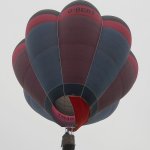 ‘Bert’ after the registration happened to come through as G-BERT, is a Cameron Viva 56, s/n 273, built in 1977 out of lightweight fabric, came in at 57kg and still does 50 minutes a cylinder. The secret? Well don’t take more fuel than you need. David never flew either of his balloons with more than two cylinders. Actually he did take three cylinders on one occasion. “Well, people were amazed at one Balleroy when we strapped 3 tanks into our 65, but we were having a race with a gas balloon! We flew 3h 30m on those three tanks but he won, just. Why take four when two will do? You are just increasing the carry out load.” He’s absolutely right.
‘Bert’ after the registration happened to come through as G-BERT, is a Cameron Viva 56, s/n 273, built in 1977 out of lightweight fabric, came in at 57kg and still does 50 minutes a cylinder. The secret? Well don’t take more fuel than you need. David never flew either of his balloons with more than two cylinders. Actually he did take three cylinders on one occasion. “Well, people were amazed at one Balleroy when we strapped 3 tanks into our 65, but we were having a race with a gas balloon! We flew 3h 30m on those three tanks but he won, just. Why take four when two will do? You are just increasing the carry out load.” He’s absolutely right.
To find out more visit his smashing super website at http://dbarker.atwebpages.com